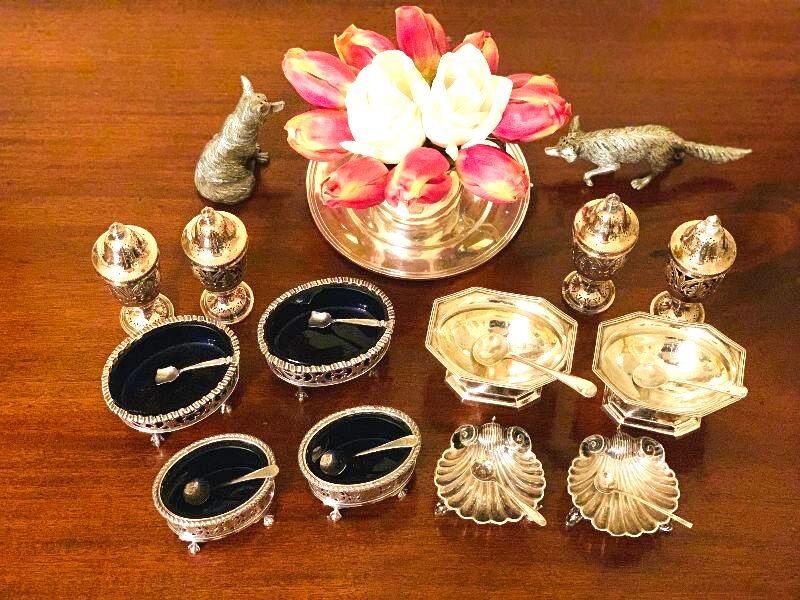I have always been enamored with the traditional cobalt blue glass liners inside of my silver salt cellars. And, how convenient that they complement the color scheme of the dining room at Fox Hall!
A classic salt cellar is a diminutive container filled with salt for a formal dinner. It is a charming, traditional accessory for an elegant place setting.
A Peek at Salt History
Salt cellars have been around since ancient Rome. Salt was a prized possession, and in the Middle Ages, a large silver dish of salt was considered a status symbol. It was placed prominently in front of the host to indicate his prosperity.
Soon, smaller petite sized salt receptacles were created for dinner guests to share. In the 1600s, small salt spoons were designed to accompany each salt cellar. In the Victorian era, an individual salt cellar was displayed for each guest to have at the table, and considered quite vogue. In the early 20th century, “salt shakers” were developed when anti-clumping salt was invented.
If you attend a dinner party and an individual (not shared) salt cellar is above your place setting without a salt spoon, you may pinch the salt with your fingers, or use the tip of your clean knife blade to take out the salt and place it on the rim of your plate or on your butter plate. If the salt cellar is shared, then do not use your fingers! Salt taken from the salt cellar, with a salt spoon, may be sprinkled over your food.
Refrain from seasoning what is served to you until you have tasted it first! It can be construed as an insult to the hostess or chef that you should choose to season their culinary creation before you make the effort to taste it.
Salt is corrosive to silver, so glass liners were designed for silver salt cellars to protect the salt from damaging the silver. Remember to remove the salt from the silver salt cellar, especially if it does not have a glass liner, and wash it to remove any salt residue.
And yes, you may use a pair of salt cellars for both salt and pepper! Salt is usually placed to the right of the pepper because most people are right-handed, and salt is requested more than pepper (even though I prefer pepper).
Salt cellars, as well as individual salt and pepper shakers, are placed above an individual place setting or, when shared, above and in between the two place settings.
Sign up for Mummy’s Monday Manners to receive new sparkling tips about etiquette and classic design every week, along with a free download of Holly’s Elegant Entertaining e-book.
Forbidden Faux Pas
No-no: To leave any salt cellars or shakers on the table after dinner, when the dessert is served.
What is done: Remove the cellars before dessert is served.
No-no: To pass only the salt or just the pepper.
What is done: When asked to pass the salt or pepper, always pass them together.
No-no: To dip your food into the salt cellar.
Millennial Tip
For an informal dinner, consider using your salt cellars to hold a few chocolate covered coffee beans, spiced nuts, or even a flower blossom or two. Place one at the top of a place setting or around the centerpiece or flower arrangement. A white gardenia blossom, or a little rose blossom with a few tiny green leafs can be quite elegant in a salt cellar… who would have ever thought!

